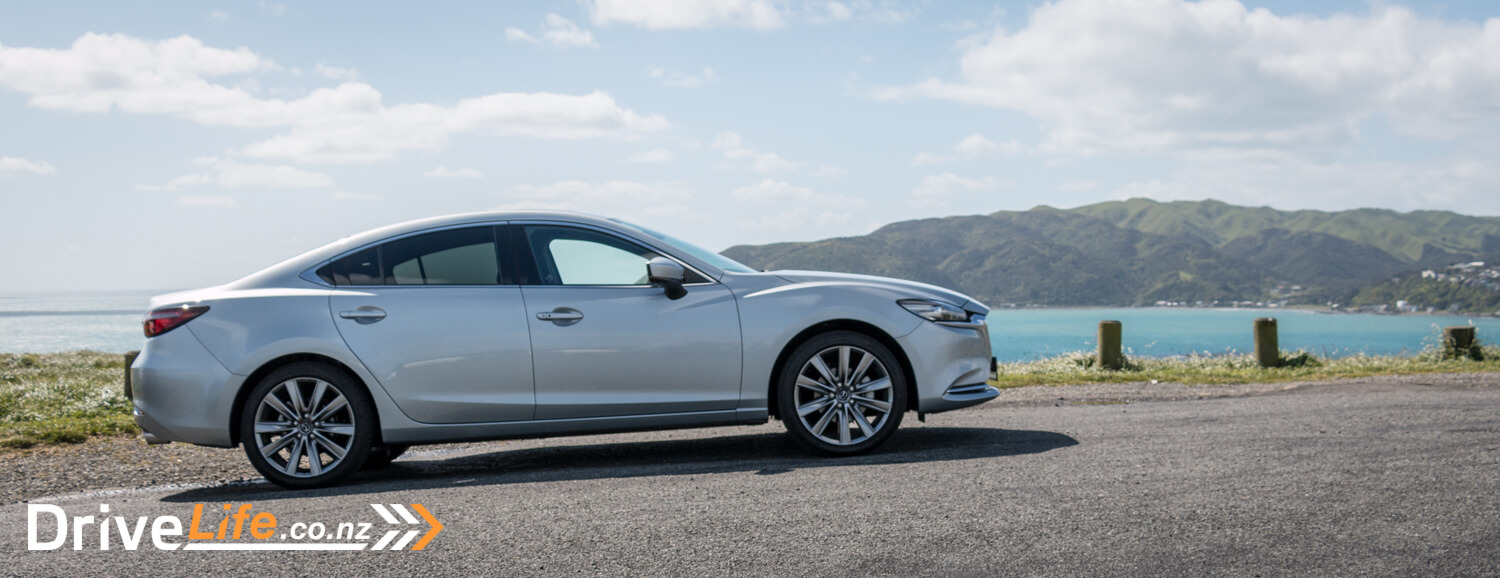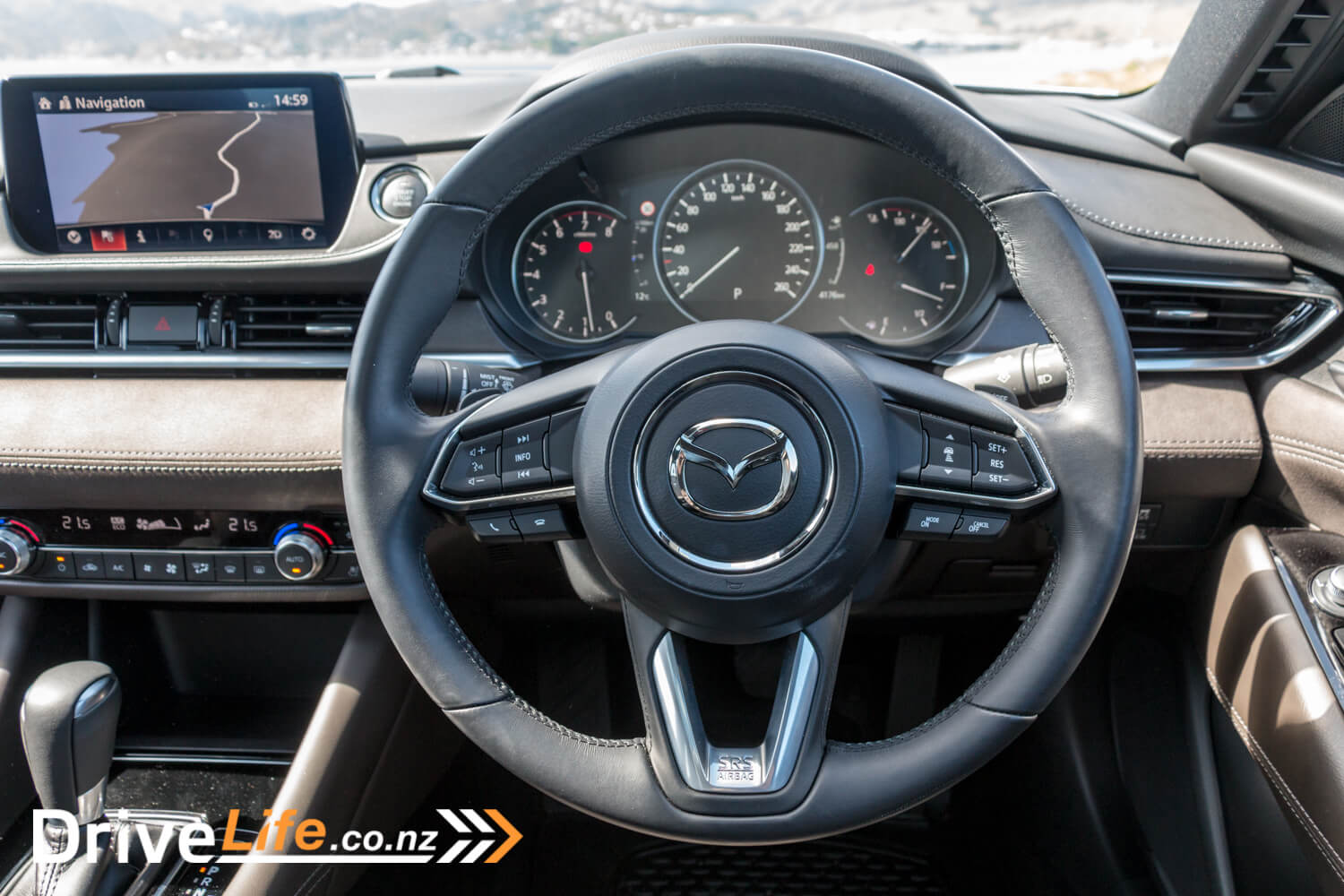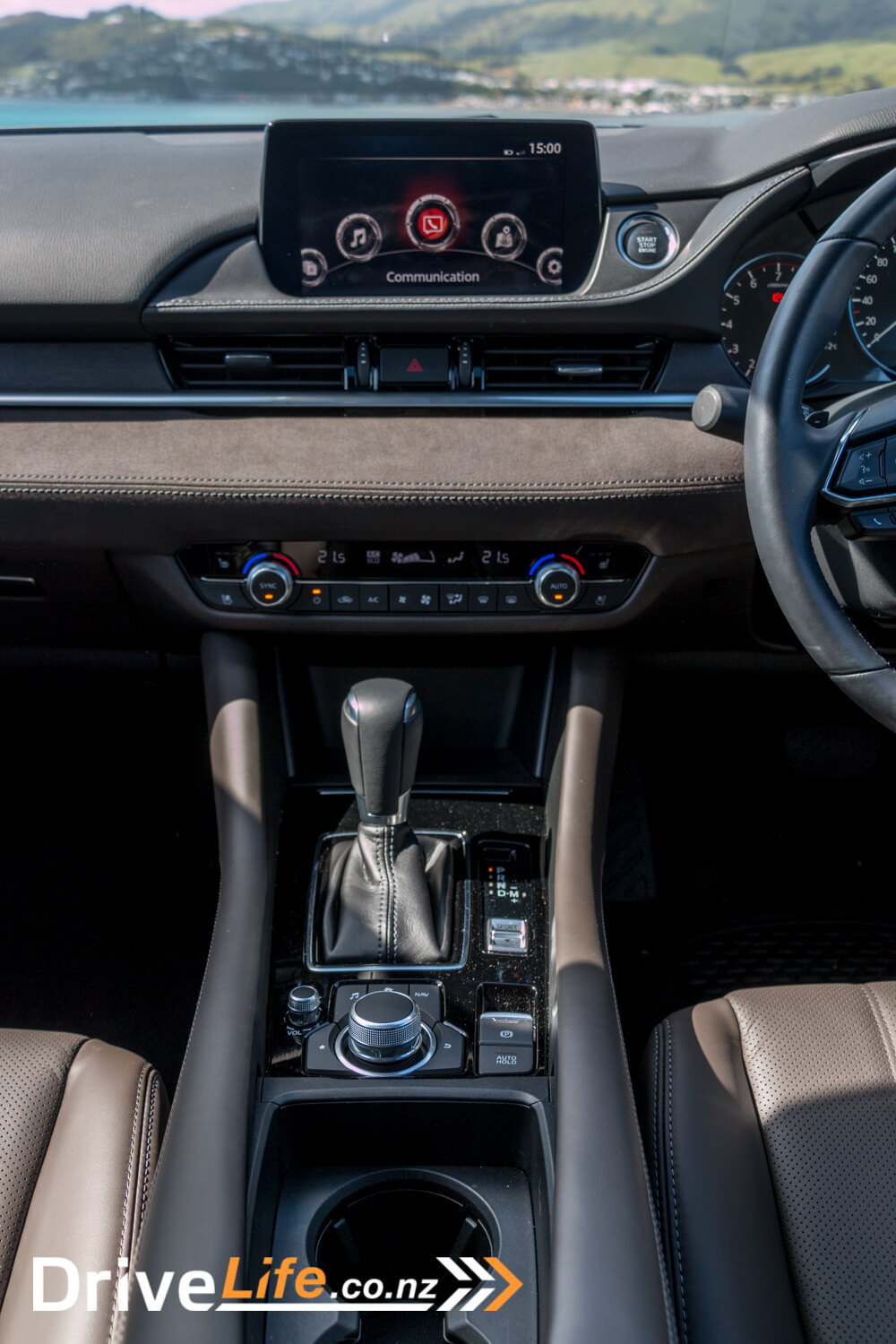When I tested the top-spec Mazda6 Limited last year, I really enjoyed it, but it did have a couple of minor issues. Now in the 2018 facelifted car there’s a new top top spec, the Takami. According to Google, it means “higher”. Mazda have refined the design, added features, and replaced the already peppy 2.5-litre engine with a new 2.5-litre turbo.
Would this make the perfect Mazda6? We drove one for a week to find out.

What’s In The 2018 Mazda6 Range?
There are six variants of Mazda6 – the GSX, available as a petrol Sedan at $45,995, petrol wagon at $46,995 or diesel wagon at $49,295. There’s Limited spec at $51,195 for the petrol sedan or $54,495 for the diesel wagon. Finally there’s the Limited Takami at $56,995.
The GSX and Limited have either a 4-cylinder 2.5-litre petrol engine which makes 140kW/252Nm, or a 4-cylinder 2.2-litre turbodiesel which makes 140kW/450Nm. The Takami has the new 2.5-litre turbo petrol, which makes 170kW/420Nm. All have the same 6-speed Skyactiv Drive transmission.
The GSX may be the entry model but it’s not short on features, including 17-inch alloys, auto LED headlamps, heated power mirrors, dual-zone climate control with rear vents, heads-up display, auto-dimming rear-view mirror, 8-inch touch screen, 6 speaker audio, electric parking brake, leather wrapped gear knob and steering wheel, paddle shifters, satnav, keyless entry, push-button start, reversing camera, front & rear parking sensors, Advanced Smart City Brake Support, Blind Spot Monitoring, Rear Cross Traffic Alert, High Beam Control, Smart Brake Support, Mazda Radar Cruise Control, Lane Departure Warning, Lane-keep Assist, Driver Attention Alert, Traffic Sign Recognition, and Intelligent Speed Assistance.
The Limited adds the following extra features: 19-inch alloys, LED daytime running lights, LED tail-lamps, Power sunroof, privacy glass, Black or Pure White leather seats, power adjusted front seats with memory for driver, front and rear heated seats, Bose 231 watt amplifier and 11 speakers with subwoofer, and Adaptive LED Headlamps.
As well as the new engine, the Takami adds the following over the Limited: ventilated front seats, Oriental Brown or Pure White Nappa leather seats, 7-inch multi-information display, Ambient LED lighting, black cabin headliner, frameless rear-view mirror with auto-dimming function, ‘Sen’ wood door and dashboard trim inserts, Ultrasuede door and dashboard trim inserts, and a 360° View Monitor.
There are eight colours available: Snowflake White Pearl Mica, Sonic Silver Metallic Blue Reflex Mica, Soul Red Crystal Metallic, Machine Grey Metallic, Titanium Flash Mica, Deep Crystal Blue Mica and Jet Black Mica.
Mostly pretty muted shades, but Soul Red is the one to have in my opinion. It costs a few hundred dollars extra, but it’s a gorgeous deep, glossy red.

First Impressions Of The 2018 Mazda6 Takami
The Mazda6 was already a great looking car, and this facelift hasn’t messed with the formula too much. The 19” wheels and sweeping lines somehow make it look smaller than its 4.8m length. I love the frowny headlights and angled rears. To me, the sweeping lines and creases of the front have almost Jaguar-like looks. The twin exhausts finish the rear off nicely, and bucking recent trends in car design , they are real, not just fancy trims.
The overall package is classy and handsome.

What’s The Inside Like On A 2018 Mazda6 Takami?
The interior of the Takami is what really lifts it above the other cars in the Mazda6 range. I have to admit that my first reaction was to dislike the brown leather, as it’s not normally my thing. Once I sat inside the Takami, closing the door with a reassuring thunk, it all started to make sense. There’s a mix of materials, with soft-touch plastic at the top of the dash and doors, separated from a brown suede section by an aluminium trim, then brown leather below. There’s also a small real wood panel in the doors.
It all fits together very well, and looks really classy. I remember thinking that Mazda must have been taking note of current BMW interiors, as the Takami has a similar feel to a 3-Series. There’s padded leather trim on the centre console, and exposed stitching on the suede part of the dash. Dash buttons are kept to a minimum, with a narrow strip of controls for the climate control and demisters. The 8” central touch screen has a familiar interface if you’ve driven recent Mazdas, with its clear and simple look, and easy control using either the touch function or the click/jog wheel near the gear shifter.
The screen isn’t as big as the ones in some cars, but it’s clear, and provides a great image for the 360-degree camera system. There are parking sensors all-round too, making the Mazda6 easy to park.

The steering wheel is leather-trimmed and has thumb controls for the stereo, cruise control and phone functions. They’re all laid out logically enough and are easy to get used to. The wheel is comfortable to hold, and fits in with the executive feel of this car rather than being sporty.
Mazda have gone for a three-dial dash cluster with rev counter on the left, fuel and temperature on the right, and a large digital central speedo designed to look like an analogue gauge. The centre section of the speedo can be changed to various displays including cruise control, music, satnav etc. There’s also a digital fuel gauge just next to the analogue one for some reason. Mazda have used the digital speedo to show some information graphically. As well as being shown in the corner, the current speed limit is marked in red on the outside of the speedo. If you go over it fills in the border in red too as a visual indicator, as well as flashing the speed sign in the HUD and display. Not only that, if you’re approaching a camera it announces “Approaching speed camera” over the speakers and follows with “reduce your speed”. Cruise control set speed is also highlighted on the outside of the speedo.
The Mazda6 has a colour HUD as standard across the range, which is a great feature, and Mazda’s system is one of the better ones, showing speed, current speed limit, satnav directions, and swooshes either side if someone is in your blind spot. It’s laid out clearly and soon becomes second-nature to read, to the point where you really miss it when you go back to a car that doesn’t have one.

Talking of the satnav directions, they can be excellently complex – for example one direction I got was “after two hundred metres, turn left onto xxx street, then turn right to reach your destination” Really clear, natural sounding, and helpful. I was impressed.
The seats look really good, and are very comfortable. There’s 10-way electric adjustment and memory on the driver’s side, and 6-way electric adjustment on the passenger side. The wheel adjusts in four directions, making the perfect driving position easy to achieve. I like the aluminium trim strip in the seat back, it’s a bit different and not noticeable when sitting in the seat. It’s repeated in the rear seats, which are also comfortable, with good amounts of leg room. All seats front and rear are heated, with ventilation available as well on the fronts.
The rear seats are 60/40 split and fold almost flat to enable you to carry longer loads. As it’s a sedan, the gap from the boot to the rear seats isn’t huge, but it’s pretty good. The boot itself is large and deep, giving you 474 litres of storage. There are a couple of little trays at the sides, but not much in the way of bag hooks or useful storage features.

What’s The 2018 Mazda6 Takami Like To Drive?
Test number one – Bluetooth pairing – was completed without hassle, and the Mazda returns to Bluetooth when you get re-start the car, which is always appreciated. The 11-speaker Bose system is very good, with good clarity and a subwoofer to provide excellent bass.
Once that essential step was performed, it was out into the usual rush-hour traffic. Time to test the smart cruise control. In the last model this turned off under 30kph, but the new improved system can come to a complete stop, starting again with a tap of the throttle or the resume button. It works really well, anticipating well and braking smoothly most of the time. Some of these systems can feel a bit jerky, but Mazda’s is less jerky than many others.
There’s also steering assist, which will provide steering input if it thinks you’re about to drift out of your lane, or if you aren’t turning a corner. I found it to be a bit intrusive on the Mazda6 and ended up fighting it when it tried to make a correction. A lot of these systems struggle to see the lanes properly around Wellington and maybe this was the issue, but a couple of times it steered me over the line to the left, then beeped a lane departure warning at me. The system can be turned off if required.
One thing I noticed when cruising in traffic was that the system that reads speed limit signs wasn’t always 100% accurate. Most of the time it was, but it seemed to struggle with the overhead gantry signs and would revert back to the road speed from its maps.

Driving at motorway speeds was a pleasant experience, with road and wind noise very well damped, and barely a noticeable sound or vibration from the engine. The Takami definitely has that premium feel, a car that you could go take long trips and arrive feeling fresh. The suspension is set up to be comfortable, not too firm but not soft either. Mazda have found a good balance here.
You might think in a car that rides this comfortably, that if you decide to sneak off for some driving fun on a twisty back road you’d be disappointed. But this is not the case with the Mazda6 – Mazda have a clever system called G-Vectoring Control which controls engine torque based on steering and accelerator positions to improve handling. And it works beautifully, providing great handling and less body roll.
The Takami has a good amount of power, with 170kW, but more importantly adding a turbo has upped the torque from 252 to 420Nm over the 2.5-litre. This makes a massive difference to driveability and the way the car pulls out of corners. It’s tuned more for progressive acceleration than outright speed – remember this is a smooth executive express rather than a performance model. And it works really well, providing a very satisfying drive.
There’s more clever technology in the Takami too, such as the i-ELOOP energy regeneration system, which harvests braking energy to a capacitor and uses it to power electrical systems. There’s auto high beams which detect oncoming and preceding vehicles and bends the beam to avoid dazzling other road users.

What’s The Competition For The 2018 Mazda6 Takami?
There aren’t than many larger family cars around these days, so competition in a similar price bracket is scarce.
| Brand/Model | Engine | Power/ Torque |
Fuel, L/100km | Seats | Boot Space, Litres |
Price |
| Kia Stinger GT Line Fastback | 2.0-litre 4 cylinder turbo | 182kW/353Nm | 8.8 | 5 | 660 | $59,990 |
| Mazda6 Takami | 2.5-litre 4 cylinder turbo | 170kW/420Nm | 7.6 | 5 | 474 | $56,995 |
| Skoda Octavia RS245 Liftback | 2.0-litre 4 cylinder turbo | 180kW/370Nm | 6.5 | 5 | 660 | $55,990 |
| Kia Optima Turbo GT | 2.0-litre 4 cylinder turbo | 180kW/350Nm | 8.5 | 5 | 510 | $53,990 |
| Ford Mondeo Titanium Hatchback | 2.0-litre 4 cylinder turbo | 177k&/345Nm | 8.5 | 5 | 525 | $53,690 |
| Holden Commodore RS Liftback | 2.0-litre 4 cylinder turbo | 191kW/350Nm | 7.6 | 5 | 490 | $49,990 |

What’s The Pros And Cons For The 2018 Mazda6 Takami?
| Pros | Cons |
|
|

What Do We Think Of The 2018 Mazda6 Takami?
I really liked the Mazda6 Takami. It looks great, is luxurious inside, it’s quick and it’s fun to drive. It has lots of equipment and technology, though there are a couple of quirks.
I said above that Mazda seem to have taken note of, and emulated, what BMW are doing, and I meant that as a compliment. This car really is a step up in interior quality and style. This car definitely has a premium feel in all aspects.
When most manufacturers seem to be are moving to all SUVs, I’m glad Mazda have continued to develop a big family sedan.

Rating – Chevron rating (4.5 out of 5)
2018 Mazda6 Takami – Specifications
| Vehicle Type | Medium 5-Door Sedan |
| Starting Price | $56,995 plus on-road costs |
| Tested Price | $56,995 plus on-road costs |
| Engine | 2.5-litre turbo in-line 4 cylinder 16 valve DOHC S-VT petrol engine with i-stop |
| Power Kw / Torque Nm | 170/420 |
| Transmission | 6-speed (SKYACTIV-Drive) automatic |
| 0 – 100 kph, seconds | Not quoted |
| Spare Wheel | Space saver |
| Kerb Weight, Kg | 1620 |
| Length x Width x Height, mm | 4865 x 1840 x 1450 |
| Cargo Capacity, litres | 474 seats up |
| Fuel Tank, litres | 62 |
| Fuel Efficiency | Advertised Spec – Combined – 7.6L / 100km Real World Test – Combined – 9.4L / 100km Low Usage: 0-6 / Medium Usage 6-12 / High Usage 12+ |
| Towing | 750kg unbraked 1600kg braked |
| Turning circle | 11.2m Small: 6-10m / Medium 10-12m / Large 12m+ |
| Warranty | 5 years unlimited kilometres |
| ANCAP Rating | 5 stars |
























